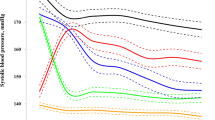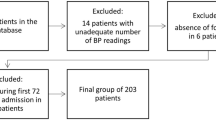Abstract
To examine the association between blood pressure (BP) variability measured within 24 h after admission for acute ischemic stroke and functional outcome 30 days after stroke onset and to find outcome predictors. A total of 174 patients were included in this retrospective study. Supine BP was measured every 4 h during the first 24 h after admission. The functional outcome was assessed using the modified Rankin Scale. BP parameters including systolic blood pressure (SBP), diastolic blood pressure (DBP), mean arterial pressure (MAP), and pulse pressure (PP) were examined. A set of six variability indices was calculated, including standard deviation (SD), successive variation (SV), difference between maximum and minimum value (DMM), and maximal successive change (MSC). Patients with high SBP or PP variability measures were significantly more likely to develop an unfavorable outcome. All PP variability indices displayed the highest correlations with the outcome. This association was confirmed in logistic regression analysis, both in univariable model and a model adjusted to the baseline National Institute of Health Stroke Scale score and mean BP (the OR for an unfavorable outcome following a 10-mmHg increase in SD, SV, MSC, and DMM parameters was in the interval 1.4–2.7, p < 0.05). Following receiver operating characteristic analysis, the PP parameters yielded area under the curve (AUC) values between 0.654 and 0.666, p < 0.005. Thus, in the acute phase of ischemic stroke, the SD and MSC indices of PP variability during the first 24 h after admission were robustly associated with patients’ 30-day outcomes and served as predictors of unfavorable outcomes with thresholds of 14 and 26 mmHg, respectively.
This is a preview of subscription content, access via your institution
Access options
Subscribe to this journal
Receive 12 print issues and online access
$259.00 per year
only $21.58 per issue
Buy this article
- Purchase on Springer Link
- Instant access to full article PDF
Prices may be subject to local taxes which are calculated during checkout

Similar content being viewed by others
References
Qureshi AI, Qureshi MH. Acute hypertensive response in patients with intracerebral hemorrhage pathophysiology and treatment. J Cereb Blood Flow Metab. 2018;38:1551–63.
Leonardi-Bee J, Bath PMW, Phillips SJ, Sandercock PAG. Blood pressure and clinical outcomes in the International Stroke Trial. Stroke. 2002;33:1315–20.
Jordan JD, Powers WJ. Cerebral autoregulation and acute ischemic stroke. Am J Hypertens. 2012;25:946–50.
Sandset EC. Blood pressure in acute stroke. Lancet Neurol. 2014;13:342–3.
Vemmos KN, Tsivgoulis G, Spengos K, Zakopoulos N, Synetos A, Manios E, et al. U-shaped relationship between mortality and admission blood pressure in patients with acute stroke. J Intern Med. 2004;255:257–65.
Berge E, Cohen G, Lindley RI, Sandercock P, Wardlaw JM, Sandset EC, et al. Effects of blood pressure and blood pressure-lowering treatment during the first 24 h among patients in the Third International Stroke Trial of Thrombolytic Treatment for Acute Ischemic Stroke. Stroke. 2015;46:3362–9.
ENOS Trial Investigators Efficacy of nitric oxide, with or without continuing antihypertensive treatment, for management of high blood pressure in acute stroke (ENOS): a partial-factorial randomised controlled trial. Lancet. 2015;385:617–28.
Ji M, Li S-J, Hu W-L. Effects of different antihypertensive drugs on blood pressure variability in patients with ischemic stroke. Eur Rev Med Pharm Sci. 2014;18:2491–5.
Anderson CS, Huang Y, Lindley RI, Chen X, Arima H, Chen G, et al. Intensive blood pressure reduction with intravenous thrombolysis therapy for acute ischaemic stroke (ENCHANTED): an International, Randomised, Open-Label, Blinded-Endpoint, Phase 3 Trial. Lancet. 2019;393:877–88.
Kellert L, Hametner C, Ahmed N, Rauch G, MacLeod MJ, Perini F, et al. Reciprocal interaction of 24-hour blood pressure variability and systolic blood pressure on outcome in stroke thrombolysis. Stroke. 2017;48:1827–34.
Ntaios G, Lambrou D, Michel P. Blood pressure change and outcome in acute ischemic stroke: the impact of baseline values, previous hypertensive disease and previous antihypertensive treatment. J Hypertens. 2011;29:1583–9.
de Havenon A, Bennett A, Stoddard GJ, Smith G, Chung L, O’Donnell S, et al. Determinants of the impact of blood pressure variability on neurological outcome after acute ischaemic stroke. Stroke Vasc Neurol. 2017;2:1–6.
Pringle E, Phillips C, Thijs L, Davidson C, Staessen JA, de Leeuw PW, et al. Systolic blood pressure variability as a risk factor for stroke and cardiovascular mortality in the elderly hypertensive population. J Hypertens. 2003;21:2251–7.
Manning LS, Rothwell PM, Potter JF, Robinson TG. Prognostic significance of short-term blood pressure variability in acute stroke: systematic review. Stroke. 2015;46:2482–90.
Manning L, Hirakawa Y, Arima H, Wang X, Chalmers J, Wang J, et al. Blood pressure variability and outcome after acute intracerebral haemorrhage: a post-hoc analysis of INTERACT2, a randomised controlled trial. Lancet Neurol. 2014;13:364–73.
Endo K, Kario K, Koga M, Nakagawara J, Shiokawa Y, Yamagami H, et al. Impact of early blood pressure variability on stroke outcomes after thrombolysis: the SAMURAI rt-PA registry. Stroke. 2013;44:816–8.
Tomii Y, Toyoda K, Suzuki R, Naganuma M, Fujinami J, Yokota C, et al. Effects of 24-hour blood pressure and heart rate recorded with ambulatory blood pressure monitoring on recovery from acute ischemic stroke. Stroke. 2011;42:3511–7.
Polish Neurological Society. Wytyczne postępowania w udarze mózgu. Pol Prz Neurol. 2019;15 Suppl A:A1–A156.
Michalak S, Kazmierski R, Hellmann A, Wysocka E, Kocialkowska-Adamczewska D, Wencel-Warot A, et al. Serum paraoxonase/arylesterase activity affects outcome in ischemic stroke patients. Cerebrovasc Dis. 2011;32:124–32.
Dawson SL, Manktelow BN, Robinson TG, Panerai RB, Potter JF. Which parameters of beat-to-beat blood pressure and variability best predict early outcome after acute ischemic stroke? Stroke. 2000;31:463–8.
Kang J, Ko Y, Park JH, Kim W-J, Jang MS, Yang MH, et al. Effect of blood pressure on 3-month functional outcome in the subacute stage of ischemic stroke. Neurology. 2012;79:2018–24.
Adams HP, Leclerc JR, Bluhmki E, Clarke W, Hansen MD, Hacke W. Measuring outcomes as a function of baseline severity of ischemic stroke. Cerebrovasc Dis. 2004;18:124–9.
Domanski MJ, Davis BR, Pfeffer MA, Kastantin M, Mitchell GF. Isolated systolic hypertension: prognostic information provided by pulse pressure. Hypertension. 1999;34:375–80.
Millar JA, Lever AF, Burke V. Pulse pressure as a risk factor for cardiovascular events in the MRC Mild Hypertension Trial. J Hypertens. 1999;17:1065–72.
Hayes A, Krippendorff K. Answering the call for a standard reliability measure for coding data. Commun Methods Measures. 2007;1:77–89.
Lasko TA, Bhagwat JG, Zou KH, Ohno-Machado L. The use of receiver operating characteristic curves in biomedical informatics. J Biomed Inform. 2005;38:404–15.
Kamieniarz M, Włodarska M, Tokłowicz R, Łukomski T, Kaźmierski R. Wpływ zmienności ciśnienia tętniczego krwi w pierwszej dobie udaru niedokrwiennego mózgu na przebieg choroby. Anestezjologia i Ratow 2014;8:144–51.
Veloudi P, Sharman JE. Methodological factors affecting quantification of blood pressure variability: a scoping review. J Hypertens. 2018;36:711–19.
Kario K, Shin J, Chen C-H, Buranakitjaroen P, Chia Y-C, Divinagracia R, et al. Expert panel consensus recommendations for ambulatory blood pressure monitoring in Asia: The HOPE Asia Network. J Clin Hypertens. 2019;21:1250–83.
Ko Y, Park JH, Yang MH, Ko S-B, Han M-K, Oh CW, et al. The significance of blood pressure variability for the development of hemorrhagic transformation in acute ischemic stroke. Stroke. 2010;41:2512–8.
Xu J, Liu Y, Wang A, Gao Y, Wang Y, Wang Y. Blood pressure fluctuation pattern and stroke outcomes in acute ischemic stroke. Hypertens Res. 2019;42:1776–82.
Martins AI, Sargento-Freitas J, Jesus-Ribeiro J, Correia I, Cardoso L, Gomes JP, et al. Blood pressure variability in acute ischemic stroke: the role of early recanalization. Eur Neurol. 2018;80:63–67.
Buratti L, Cagnetti C, Balucani C, Viticchi G, Falsetti L, Luzzi S, et al. Blood pressure variability and stroke outcome in patients with internal carotid artery occlusion. J Neurol Sci. 2014;339:164–8.
Selvaraj S, Steg PG, Elbez Y, Sorbets E, Feldman LJ, Eagle KA, et al. Pulse pressure and risk for cardiovascular events in patients with atherothrombosis: from the REACH Registry. J Am Coll Cardiol. 2016;67:392–403.
Geeganage C, Tracy M, England T, Sare G, Moulin T, Woimant F, et al. Relationship between baseline blood pressure parameters (including mean pressure, pulse pressure, and variability) and early outcome after stroke: data from the Tinzaparin in Acute Ischaemic Stroke Trial (TAIST). Stroke. 2011;42:491–3.
Lewington S, Clarke R, Qizilbash N, Peto R, Collins R, Prospective Studies Collaboration. Age-specific relevance of usual blood pressure to vascular mortality: a meta-analysis of individual data for one million adults in 61 prospective studies. Lancet. 2002;360:1903–13.
Boehme AK, Esenwa C, Elkind MSV. Stroke risk factors, genetics, and prevention. Circ Res. 2017;120:472–95.
Kass DA. Age-related changes in venticular-arterial coupling: pathophysiologic implications. Heart Fail Rev. 2002;7:51–62.
Steppan J, Barodka V, Berkowitz DE, Nyhan D. Vascular stiffness and increased pulse pressure in the aging cardiovascular system. Cardiol Res Pract. 2011;2011:263585.
O’Rourke MF, Safar ME. Relationship between aortic stiffening and microvascular disease in brain and kidney: cause and logic of therapy. Hypertension. 2005;46:200–4.
Chen Y, Shen F, Liu J, Yang G-Y. Arterial stiffness and stroke: de-stiffening strategy, a therapeutic target for stroke. Stroke Vasc Neurol. 2017;2:65–72.
Avolio AP, Kuznetsova T, Heyndrickx GR, Kerkhof PLM, Li JK-J. Arterial flow, pulse pressure and pulse wave velocity in men and women at various ages. Adv Exp Med Biol. 2018;1065:153–68.
Mattace-Raso FUS, van der Cammen TJM, Hofman A, van Popele NM, Bos ML. Schalekamp MADH, et al. Arterial stiffness and risk of coronary heart disease and stroke: the Rotterdam Study. Circulation. 2006;113:657–63.
Dolan E, Thijs L, Li Y, Atkins N, McCormack P, McClory S, et al. Ambulatory arterial stiffness index as a predictor of cardiovascular mortality in the Dublin Outcome Study. Hypertension. 2006;47:365–70.
Geeganage C, Sare G, Bath PMW. Pulse pressure as a predictor of stroke. Expert Rev Neurother. 2008;8:165–7.
Sprigg N, Gray LJ, Bath PMW, Boysen G, De Deyn PP, Friis P, et al. Relationship between outcome and baseline blood pressure and other haemodynamic measures in acute ischaemic stroke: data from the TAIST trial. J Hypertens. 2006;24:1413–7.
de Havenon A, Bennett A, Stoddard GJ, Smith G, Wang H, Wold J, et al. Increased blood pressure variability is associated with worse neurologic outcome in acute anterior circulation ischemic stroke. Stroke Res Treat. 2016;2016:7670161.
Delgado-Mederos R, Ribo M, Rovira A, Rubiera M, Munuera J, Santamarina E, et al. Prognostic significance of blood pressure variability after thrombolysis in acute stroke. Neurology. 2008;71:552–8.
Minhas JS, Wang X, Lavados PM, Moullaali TJ, Arima H, Billot L, et al. Blood pressure variability and outcome in acute ischemic and hemorrhagic stroke: a post hoc analysis of the HeadPoST study. J Hum Hypertens. 2019;33:411–8.
Manning LS, Mistri AK, Potter J, Rothwell PM, Robinson TG. Short-term blood pressure variability in acute stroke: post hoc analysis of the controlling hypertension and hypotension immediately post stroke and continue or stop post-stroke antihypertensives collaborative study trials. Stroke. 2015;46:1518–24.
Acknowledgements
We thank Professor J. Moczko for suggestions and discussion during statistical analysis.
Author information
Authors and Affiliations
Corresponding author
Ethics declarations
Conflict of interest
The authors declare that they have no conflict of interest.
Additional information
Publisher’s note Springer Nature remains neutral with regard to jurisdictional claims in published maps and institutional affiliations.
Rights and permissions
About this article
Cite this article
Kamieniarz-Mędrygał, M., Łukomski, T. & Kaźmierski, R. Short-term outcome after ischemic stroke and 24-h blood pressure variability: association and predictors. Hypertens Res 44, 188–196 (2021). https://doi.org/10.1038/s41440-020-00534-9
Received:
Revised:
Accepted:
Published:
Issue Date:
DOI: https://doi.org/10.1038/s41440-020-00534-9
Keywords
This article is cited by
-
The impact of blood pressure variability on the development of parenchymal hematoma in acute cerebral infarction with atrial fibrillation
Hypertension Research (2024)
-
Blood pressure variability predicts poor outcomes in acute stroke patients without thrombolysis: a systematic review and meta-analysis
Journal of Neurology (2024)
-
Significance of pulse pressure variability in predicting functional outcome in acute ischemic stroke: a retrospective, single-center, observational cohort study
Scientific Reports (2023)



